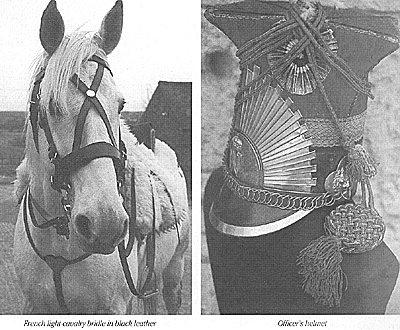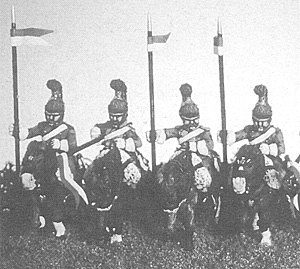When
Napoleon ordered the formation of the line lancer regiments in
1811 they were constituted around the regimental depots, recruits
being brought in and trained up to raise the regiments to strength
for the 1812 campaign.
Lancer regiments 1 to 6 were supposedly dressed to the
sartorial elegance set down in the decree of 15th July 1811,
whereby the mid green tunic (known as a habit-veste) was faced in
a different colour for each of the six regiments.
Cuffs were to be of the pointed variety rather than the
dragoons straight pattern. Facing colour was on the collar, cuffs,
turnbacks and lapels. The front of the habit-veste could button
over to obscure the facing colour, the reverse being mid-green.
An interesting example of an officers habit-veste is on
display in the museum in Salon de Provannce. This belonged to an
officer of the Ist Lancer Regiment circa 1815, the left turnback has
two crossed lances, the right turnback carries a bourbon lillie.
Under the 1st Empire the line companies were supposed
to have eagle patches on their turnbacks with grenade patches for
the elite companies. All buttons on the tunic were to be of yellow
metal embossed with regimental numbers.
Breeches were of a middle green colour, in the Hungarian
style, with a yellow side stripe, the front having, in the case of the
1st to 4th regiments an inverted arrowhead device, also in yellow.
Regiments 5 and 6 had a more complicated Hungarian sword knot.
On campaign the 'pantalons' or overalls were worn, these being of
the same mid green colour and re-inforced on the inner legs and seat
with black leather, a strip of regimental lace ran down the outer
seam of the legs, the buttons on the seam being of yellow metal.
Many various patterns of overalls were worn, dependent
upon what was available in the individual regimental depots. Stocks
of existing cloth had to be used before new batches were purchased,
leading to many inconsistencies and irregularities of dress. The 30th
Chasseurs for example continued with green jackets and red
trousers long after they should have been wearing blue, as the 9th
lancers. Grey was also a popular overall colour.
In the 1st to 6th lancers the head-dress was the converted
dragoons helmet. Made of a yellow copper alloy this helmet
comprised the bowl, surmounted by a 'cimmier' (crest), with a
protective leather peak to front and rear trimmed in yellow metal.
Troopers helmets had a brown fur turban, of ficers helmets had a
turban of leopard skin with a higher more elegant style. To the
front of the crest was embellished a pair of crossed lances, the crest
itself being topped by a neo-Grecian horsehair crest.
The 1812 regulations ordering the replacement of plumes
with coloured discs does not appear to have been followed. From
1812 the fatigue cap became the pokalem model in green with a
crossed lance embellishment.
Lancer saddles were comprised of beech wood with metal
bands for support, the leather covered seat was suspended above
the horses back. On campaign the troopers saddles would be
covered with a sheepskin shabraque with 'wolves' teeth edging in
the regimental colour. A mid green portmanteau was strapped
behind the cantle at the rear of the saddle, this being trimmed with
yellow lace.
Officers saddles boasted a mid green cloth shabraque
trimmed in gold lace, with a leopard skin cover over the pommel
and seat. Hungarian pattern bridle's of black leather of the light
cavalry type were utilised (see photograph). A greatcoat was tied
over the pommel and holsters whilst on the march, but this same
greatcoat would often be worn rolled in bandoleer fashion over the
right shoulder and diagonally across the body as a protection
against sword cuts when in action.
Lancer regiments seemed well down the pecking order
when it came to horse allocation, guard lancer regiments being
credited with horses of only 14 hands whilst the line regiments
received even smaller examples.
Le Chevau-Legere Lanciers Part 2 Uniforms and Regimental Histories
UNIFORM
1st Regiment: Scarlet
2nd Regiment: Orange
3rd Regiment: Pink
4th Regiment: Crimson
5th Regiment: Sky blue
6th Regiment: Madder
Red
 HORSE FURNITURE
HORSE FURNITURE
Uniforms and Horse Furniture
The First Line Lancers: Regimental History
The Second Line Lancers: Regimental History
The Third Line Lancers: Regimental History
The Fourth Line Lancers: Regimental History
The Fifth Line Lancers: Regimental History
The Sixth Line Lancers: Regimental History
Back to Napoleonic Notes and Queries # 14 Table of Contents
Back to Age of Napoleon List of Issues
Back to MagWeb Master List of Magazines
© Copyright 1994 by Partizan Press.
This article appears in MagWeb (Magazine Web) on the Internet World Wide Web.
Other articles from military history and related magazines are available at http://www.magweb.com
